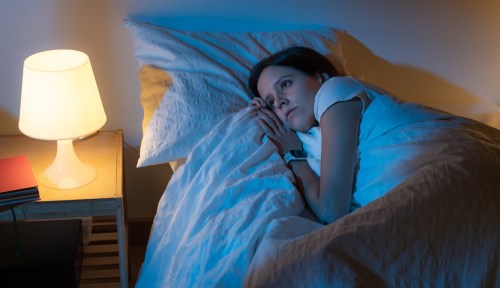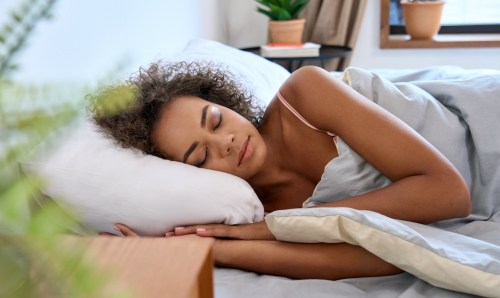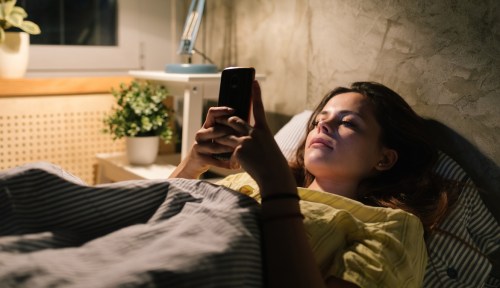Our editors independently select these products. Making a purchase through our links may earn Well+Good a commission
Why Spending *Less* Overall Time in Bed Could Help You Fall Asleep More Easily
Sleep consolidation refers to shortening the amount of time you spend in bed, so that you end up spending more of it actually sleeping.

There’s perhaps nothing more frustrating than getting into bed at a reasonable time, eager to get your doctor-recommended amount of shut-eye only to find yourself lying awake restlessly. The longer you stay in bed awake, unable to drift off, the more elusive sleep seems to become. That’s why sleep doctors often recommend that folks struggling with insomnia actually reduce their total time spent in bed through a method called sleep consolidation or restriction.
Experts in This Article
neurologist and sleep physician
neurologist, sleep specialist, and author of The Sleep Solution
It might seem counterintuitive to cut down on the time you spend in bed when what you’re looking to get is more sleep. But in people who struggle to fall asleep, there’s often a tendency to overcompensate and seek more total sleep than they need—which, ironically, backfires. “People with insomnia tend to think, ‘My sleep is failing, so I need to get more sleep and go to bed earlier,’ but that’s similar to rationalizing, ‘I never feel hungry for lunch at noon, so I probably should try to eat lunch at 11 a.m.,’” says neurologist and sleep specialist W. Chris Winter, MD, sleep advisor at Mattress Firm and author of The Sleep Solution.
In the food analogy, the person who’s not hungry at noon probably doesn’t have an appetite issue; they’re just not allowing the time for their appetite to develop. And in the same way, a person who can’t fall asleep at 11 p.m. might not have a sleep problem; they just may not be allowing their sleep drive to build enough by the time they’re getting into bed.
“Restricting the amount of time you spend trying to fall asleep can make sleep motivation higher and the drive to sleep stronger.” —W. Chris Winter, MD, neurologist and sleep specialist
Practicing sleep consolidation or restriction by waiting until later in the night to get into bed could have the effect of making this person sleepier (and, in turn, more likely to doze off easily) by the time their head hits the pillow. “Restricting the amount of time you spend trying to fall asleep can make sleep motivation higher and the drive to sleep stronger,” says Dr. Winter. Think about it this way: You likely wouldn’t struggle to fall asleep on the night following an all-nighter; you’d be tired enough to quickly pass out. To a less dramatic extent, sleep consolidation works in the same way, increasing your ability to fall and stay asleep by restricting the amount of time you’re giving yourself to do so.
Once you’re falling asleep more swiftly upon getting into bed, you’re also spending more of your total time in bed actually asleep—which, in sleep-doctor terms, means you’re boosting your sleep efficiency, says sleep neurologist Brandon Peters, MD, sleep advisor for Amazon Halo. “Sleep efficiency is the amount of time spent asleep as a percentage of the amount of time spent in bed,” he says. “For example, someone who only sleeps six hours out of eight hours in bed would have a 75 percent sleep efficiency. And most people should target somewhere in the 80 to 90 percent range.”
That high level of sleep efficiency makes you more likely to associate your bed with sleep (and not with tossing and turning), says Dr. Peters: “This leads to a conditioned response wherein the bed itself helps to promote the ability to sleep.” In other words, your brain will learn that getting into bed is its cue to go to sleep, making it that much easier to actually do so.
How to practice sleep consolidation to fall asleep more easily at night
Before you aim to consolidate your sleep, start by figuring out how much time you’re actually sleeping each night versus how much time you’re lying awake in bed and trying to sleep, so you can understand your current level of sleep efficiency and your total sleep need, says Dr. Peters. You can do this manually by keeping a sleep diary or by wearing a device that tracks your sleep, like an Apple Watch, Amazon Halo, or Oura Ring.
Then, Dr. Peters suggests subtracting the average amount of time you tend to be awake in bed from the total time you spend in bed in 15-minute increments, while still leaving yourself with at least seven hours in bed (a good minimum for sleep restriction to ensure you don’t risk deprivation). For example, if you often go to bed around 10 p.m., spend about two hours lying awake in bed, and then wake up at 7 a.m. for a total of nine hours spent in bed, start going to bed 15 minutes later each day until your bedtime is at midnight.
Along that journey, you’ll likely find that you begin to fall asleep more easily after getting into bed. Once you determine (or estimate) that you’re spending about 80 to 90 percent of your time in bed actually sleeping, you’ve effectively matched your sleep timing to your sleep need and no longer need to restrict.
While you’re consolidating, be sure to keep your wake-up time the same (and just alter your bedtime), so that you’re restricting potential sleep time but not interfering with your circadian rhythm. And steer clear of naps and any pre-bedtime sleeping—yes, that includes you, “sleep snackers”—so that your drive for sleep is always at its maximum when your new bedtime arrives.
Sign Up for Our Daily Newsletter
Get all the latest in wellness, trends, food, fitness, beauty, and more delivered right to your inbox.
Got it, you've been added to our email list.










